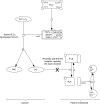Pathway databases and tools for their exploitation: benefits, current limitations and challenges
- PMID: 19638971
- PMCID: PMC2724977
- DOI: 10.1038/msb.2009.47
Pathway databases and tools for their exploitation: benefits, current limitations and challenges
Abstract
In past years, comprehensive representations of cell signalling pathways have been developed by manual curation from literature, which requires huge effort and would benefit from information stored in databases and from automatic retrieval and integration methods. Once a reconstruction of the network of interactions is achieved, analysis of its structural features and its dynamic behaviour can take place. Mathematical modelling techniques are used to simulate the complex behaviour of cell signalling networks, which ultimately sheds light on the mechanisms leading to complex diseases or helps in the identification of drug targets. A variety of databases containing information on cell signalling pathways have been developed in conjunction with methodologies to access and analyse the data. In principle, the scenario is prepared to make the most of this information for the analysis of the dynamics of signalling pathways. However, are the knowledge repositories of signalling pathways ready to realize the systems biology promise? In this article we aim to initiate this discussion and to provide some insights on this issue.
Conflict of interest statement
The authors declare that they have no conflict of interest.
Figures



Similar articles
-
Extracting reaction networks from databases-opening Pandora's box.Brief Bioinform. 2014 Nov;15(6):973-83. doi: 10.1093/bib/bbt058. Epub 2013 Aug 14. Brief Bioinform. 2014. PMID: 23946492 Free PMC article.
-
Reconn: a cytoscape plug-in for exploring and visualizing reactome.J Bioinform Comput Biol. 2013 Aug;11(4):1350004. doi: 10.1142/S0219720013500042. Epub 2013 Mar 18. J Bioinform Comput Biol. 2013. PMID: 23859268
-
Computational methodologies for modelling, analysis and simulation of signalling networks.Brief Bioinform. 2006 Dec;7(4):339-53. doi: 10.1093/bib/bbl043. Epub 2006 Nov 20. Brief Bioinform. 2006. PMID: 17116646 Review.
-
Automation of in-silico data analysis processes through workflow management systems.Brief Bioinform. 2008 Jan;9(1):57-68. doi: 10.1093/bib/bbm056. Epub 2007 Dec 2. Brief Bioinform. 2008. PMID: 18056132 Review.
-
Signaling hypergraphs.Trends Biotechnol. 2014 Jul;32(7):356-62. doi: 10.1016/j.tibtech.2014.04.007. Epub 2014 May 22. Trends Biotechnol. 2014. PMID: 24857424 Free PMC article.
Cited by
-
Comprehensive Analysis of Differentially Expressed Circular RNAs in Patients with Senile Osteoporotic Vertebral Compression Fracture.Biomed Res Int. 2020 Oct 1;2020:4951251. doi: 10.1155/2020/4951251. eCollection 2020. Biomed Res Int. 2020. PMID: 33083467 Free PMC article.
-
Synthesizing Signaling Pathways from Temporal Phosphoproteomic Data.Cell Rep. 2018 Sep 25;24(13):3607-3618. doi: 10.1016/j.celrep.2018.08.085. Cell Rep. 2018. PMID: 30257219 Free PMC article.
-
Training signaling pathway maps to biochemical data with constrained fuzzy logic: quantitative analysis of liver cell responses to inflammatory stimuli.PLoS Comput Biol. 2011 Mar;7(3):e1001099. doi: 10.1371/journal.pcbi.1001099. Epub 2011 Mar 3. PLoS Comput Biol. 2011. PMID: 21408212 Free PMC article.
-
Integrated enrichment analysis of variants and pathways in genome-wide association studies indicates central role for IL-2 signaling genes in type 1 diabetes, and cytokine signaling genes in Crohn's disease.PLoS Genet. 2013;9(10):e1003770. doi: 10.1371/journal.pgen.1003770. Epub 2013 Oct 3. PLoS Genet. 2013. PMID: 24098138 Free PMC article.
-
BiNoM 2.0, a Cytoscape plugin for accessing and analyzing pathways using standard systems biology formats.BMC Syst Biol. 2013 Mar 1;7:18. doi: 10.1186/1752-0509-7-18. BMC Syst Biol. 2013. PMID: 23453054 Free PMC article.
References
-
- Alberts B, Johnson A, Lewis J, Raff M, Roberts K, Walter P (2007) Molecular Biology of the Cell. New York, USA: Garland Science
-
- Alves R, Antunes F, Salvador A (2006) Tools for kinetic modeling of biochemical networks. Nat Biotechol 24: 667–672 - PubMed
-
- Amit I, Citri A, Shay T, Lu Y, Katz M, Zhang F, Tarcic G, Siwak D, Lahad J, Jacob-Hirsch J, Amariglio N, Vaisman N, Segal E, Rechavi G, Alon U, Mills GB, Domany E, Yarden Y (2007) A module of negative feedback regulators defines growth factor signaling. Nat Genet 39: 503–512 - PubMed
-
- Aoki-Kinoshita K, Kanehisa M (2007) KEGG Primer: An introduction to pathway analysis using KEGG, doi:10.1038/pid.2007.2. NCI-Nature Pathway Interaction Database
Publication types
MeSH terms
LinkOut - more resources
Full Text Sources
Other Literature Sources
Medical
Miscellaneous

